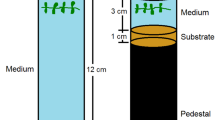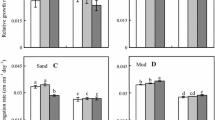Abstract
Myriophyllum aquaticum is a semi-submerged exotic macrophyte that was introduced to China for many years. This species may be found in an emergent form in aquatic environments or in an amphibious form under drained conditions. Nuisance growth of this species has often been attributed to excessive amounts of nutrients. Therefore, we tested the following hypotheses: (1) high nutrient availability facilitates the establishment of M. aquaticum and (2) fragment type interacts with nutrient availability to determine the colonization and regeneration capacities of M. aquaticum. Two types of fragments were grown in water solutions with two levels of phosphorous. After 3 weeks, the survival rates showed no significant difference between the phosphorous treatments. However, emergent fragments showed higher RGR in the low and high phosphorous treatments than amphibious fragments. In addition, emergent fragments also showed higher regeneration capacities, indicating higher invasiveness in emergent fragments compared to amphibious fragments. Moreover, the high phosphorous concentration caused emergent fragments to produce more branches, indicating that nutrient availability may increase M. aquaticum propagule pressure. Our study highlights that nutrient supply increased emergent fragment establishment and shaped the invasion dynamics of macrophytes, which could help predict the spread and potential impact of exotic macrophytes in natural aquatic ecosystems.



Similar content being viewed by others
References
Barrat-Segretain, M. H. & G. Bornette, 2000. Regeneration and colonization abilities of aquatic plant fragments: effect of disturbance seasonality. Hydrobiologia 421(1): 31–39.
Barrat-Segretain, M. H., G. Bornette & A. Hering-Vilas-Bôas, 1998. Comparative abilities of vegetative regeneration among aquatic plants growing in disturbed habitats. Aquatic Botany 60: 201–211.
Barrat-Segretain, M. H., C. P. Henry & G. Bornette, 1999. Regeneration and colonization of aquatic plants fragments in relation to the disturbance frequency of their habitat. Archiv für Hydrobiologie 145: 111–127.
Bickel, T. O., 2016. Processes and factors that affect regeneration and establishment of the invasive aquatic plant Cabomba caroliniana. Hydrobiologia. doi:10.1007/s10750-016-2995-0.
Boedeltje, G., W. A. Ozinga & A. Prinzing, 2008. The trade-off between vegetative and generative reproduction among angiosperms influences regional hydrochorous propagule pressure. Global Ecology and Biogeography 17(1): 50–58.
Carlson, R. E., 1977. A trophic state index for lakes. Limnology and Oceanography 22(2): 361–369.
Davis, M. A., J. P. Grime & K. Thompson, 2000. Fluctuating resources in plant communities: a general theory of invasibility. Journal of Ecology 88(3): 528–534.
Fleming, J. P. & E. D. Dibble, 2015. Ecological mechanisms of invasion success in aquatic macrophytes. Hydrobiologia 746(1): 23–37.
Huang, W., H. Shao, W. Li, H. Jiang & Y. Chen, 2016. Effects of urea on growth and photosynthetic metabolism of two aquatic plants (Cabomba caroliniana A. Gray and Elodea nuttallii (Planch.) H. St. John). Aquatic Botany. doi:10.1016/j.aquabot.2016.04.003.
Hussner, A., C. Meyer & J. Busch, 2009. The influence of water level and nutrient availability on growth and root system development of Myriophyllum aquaticum. Weed Research 49: 73–80.
Hussner, A., I. Stiers, M. J. J. M. Verhofstad, E. S. Bakker, B. M. C. Grutters, J. Haury, J. L. C. H. van Valkenburg, G. Brundu, J. Newman, J. S. Clayton, L. W. J. Anderson & D. Hofstra, 2017. Management and control methods of invasive alien freshwater aquatic plants: a review. Aquatic Biology 136: 112–137.
Lamberti-Raverot, B. & S. Puijalon, 2012. Nutrient enrichment affects the mechanical resistance of aquatic plants. Journal of Experimental Botany 63(17): 6115–6123.
Lange, R. & D. J. Marshall, 2016. Propagule size and dispersal costs mediate establishment success of an invasive species. Ecology 97(3): 569–575.
Lockwood, J. L., P. Cassey & T. Blackburn, 2005. The role of propagule pressure in explaining species invasions. Trends in Ecology & Evolution 20(5): 223–228.
Malheiro, A. C. E., P. Jahns & A. Hussner, 2013. CO2 availability rather than light and temperature determines growth and phenotypical responses in submerged Myriophyllum aquaticum. Aquatic Botany 110: 31–37.
Puijalon, S., T. J. Bouma, J. V. Groenendael & G. Bornette, 2008. Clonal plasticity of aquatic plant species submitted to mechanical stress: escape versus resistance strategy. Annals of Botany 102:989–996.
Redekop, P., D. Hofstra & A. Hussner, 2016. Elodea canadensis shows a higher dispersal capacity via fragmentation than Egeria densa and Lagarosiphon major. Aquatic Botany 130: 45–49.
Riis, T. & K. Sand-Jensen, 2006. Dispersal of plant fragments in small streams. Freshwater Biology 51(2): 274–286.
Santamaría, L., 2002. Why are most aquatic plants widely distributed? Dispersal, clonal growth and small-scale heterogeneity in a stressful environment. Acta Oecologica 23: 137–154.
Sheppard, A. W., R. H. Shaw & R. Sforza, 2005. Top 20 environmental weeds for classical biological control in Europe: a review of opportunities regulations and other barriers to adoption. Weed Research 46: 93–117.
Silveira, M. J., S. M. Thomaz, R. P. Mormul & F. P. Camacho, 2009. Effects of desiccation and sediment type on early regeneration of plant fragments of three species of aquatic macrophytes. International Review of Hydrobiology 94(2): 169–178.
Simberloff, D., 2009. The role of propagule pressure in biological invasions. Annual Review of Ecology, Evolution, and Systematics 40: 81–102.
Sutton, D. L., 1985. Biology and ecology of Myriophyllum aquaticum. In Proceeding, 1st International Symposium on watermilfoil (Myriophyllum spicatum) and Related Haloragaceae Species, Vancouver, B. C., 1985: 59–71.
Sytsma, M. D. & L. W. J. Anderson, 1993a. Biomass, nitrogen, and phosphorus allocation in parrotfeather (Myriophyllum aquaticum). Journal of Aquatic Plant Management 31: 244–248.
Sytsma, M. D. & L. W. J. Anderson, 1993b. Transpiration by an emergent macrophyte: source of water and implications for nutrient supply. Hydrobiologia 271(2): 97–108.
Teixeira, M. C., L. M. Bini & S. M. Thomaz, 2017. Biotic resistance buffers the effects of nutrient enrichment on the success of a highly invasive aquatic plant. Freshwater Biology 62(1): 65–71.
Thiébaut, G., 2007. Invasion success of non-indigenous aquatic and semi-aquatic plants in their native and introduced ranges. A comparison between their invasiveness in North America and in France. Biological Invasions 9(1): 1–12.
Thomaz, S. M., R. P. Mormul & T. S. Michelan, 2015. Propagule pressure, invasibility of aquatic ecosystems by non-native macrophytes and their impacts on populations, communities and ecosystems: a review of tropical freshwater ecosystems. Hydrobiologia 746: 39–59.
Umetsu, C. A., H. B. A. Evangelista & S. M. Thomaz, 2012. The colonization, regeneration, and growth rates of macrophytes from fragments: a comparison between exotic and native submerged aquatic species. Aquatic Ecology 46: 443–449.
Wang, H., Q. Wang, P. A. Bowler & W. Xiong, 2016. Invasive aquatic plants in China. Aquatic Invasions 11(1): 1–9.
Wersal, R. M. & J. D. Madsen, 2010. Comparison of subsurface and foliar herbicide applications for control of Parrotfeather (Myriophyllum aquaticum). Invasive Plant Science and Management 3: 262–267.
Wersal, R. M. & J. D. Madsen, 2011a. Comparative effects of water level variations on growth characteristics of Myriophyllum aquaticum. Weed Research 51: 386–393.
Wersal, R. M. & J. D. Madsen, 2011b. Influences of water column nutrient loading on growth characteristics of the invasive aquatic macrophyte Myriophyllum aquaticum (Vell.) Verdc. Hydrobiologia 665: 93–105.
Wersal, R. M., J. C. Cheshier, J. D. Madsen & P. D. Gerard, 2011. Phenology, starch allocation, and environmental effects on Myriophyllum aquaticum. Aquatic Botany 95: 194–199.
Xie, D. & D. Yu, 2011. Size-related auto-fragment production and carbohydrate storage in auto-fragment of Myriophyllum spicatum L. in response to sediment nutrient and plant density. Hydrobiologia 658: 221–231.
Xie, Y., Z. Li, W. P. Gregg & D. Li, 2001. Invasive species in China-an overview. Biodiversity and Conservation 10(8): 1317–1341.
Xie, Y., W. Luo, B. Ren & F. Li, 2007. Morphological and physiological responses to sediment type and light availability in roots of the submerged plant Myriophyllum spicatum. Annals of Botany 100: 1517–1523.
Xie, D., D. Yu, L. F. Yu & C. H. Liu, 2010. Asexual propagations of introduced exotic macrophytes Elodea nuttallii, Myriophyllum aquaticum, and M. propinquum are improved by nutrient-rich sediments in China. Hydrobiologia 655: 37–47.
Xie, D., D. Yu, W. H. You & C. X. Xia, 2013. The propagule supply, litter layers and canopy shade in the littoral community influence the establishment and growth of Myriophyllum aquaticum. Biological Invasions 15: 113–123.
You, W., D. Yu, C. Liu, D. Xie & W. Xiong, 2013a. Clonal integration facilitates invasiveness of the alien aquatic plant Myriophyllum aquaticum L. under heterogeneous water availability. Hydrobiologia 718(1): 27–39.
You, W., D. Yu, C. Liu, D. Xie & W. Xiong, 2013b. Clonal integration facilitates invasiveness of the alien aquatic plant Myriophyllum aquaticum L. under heterogeneous water availability. Hydrobiologia 718: 27–39.
You, W., D. Yu, D. Xie & L. Yu, 2013c. Overwintering survival and regrowth of the invasive plant Eichhornia crassipes are enhanced by experimental warming in winter. Aquatic Biology 19: 45–53.
You, W. H., D. Yu, D. Xie, C. Han & C. Liu, 2014. The invasive plant Alternanthera philoxeroides benefits from clonal integration in response to defoliation. Flora 209: 666–673.
You, W. H., C. Han, L. Fang & D. Du, 2016. Propagule pressure, habitat conditions and clonal integration influence the establishment and growth of an invasive clonal plant, Alternanthera philoxeroides. Frontiers in Plant Science 7: 568.
Zedler, J. & S. Kercher, 2004. Causes and consequences of invasive plants in wetlands: opportunities, opportunists, and outcomes. Critical Reviews in Plant Sciences 23(5): 431–452.
Zhang, Y. Y., D. Y. Zhang & S. C. H. Barrett, 2010. Genetic uniformity characterizes the invasive spread of water hyacinth (Eichhornia crassipes), a clonal aquatic plant. Molecular Ecology 19(9): 1774–1786.
Acknowledgements
We thank Ms. He Bai, Huijun Wang, and Mr. Huhui Chen for their laboratory/field assistance and helpful discussions. This research was supported by The Major Science and Technology Program for Water Pollution Control and Treatment (2015ZX07503-005-007), The National Natural Science Foundation of China (31370382), a project funded by the Priority Academic Program Development of Jiangsu Higher Education Institutions (PAPD), a start-up fund of Nanjing Forestry University (GXL035), and Forestry Science and Technology Innovation and Extension Program of Jiangsu (LYKJ[2017]10). R. P. Mormul is the Productivity Researcher of the Brazilian Council for Scientific and Technological Development (CNPq) and acknowledges this agency for continuous funding. The constructive comments of the reviewers and the editor helped to greatly improve the manuscript.
Author information
Authors and Affiliations
Corresponding authors
Additional information
Guest editors: John E. Havel, Sidinei M. Thomaz, Lee B. Kats, Katya E. Kovalenko & Luciano N. Santos / Aquatic Invasive Species II
Rights and permissions
About this article
Cite this article
Xie, D., Hu, Y., Mormul, R.P. et al. Fragment type and water nutrient interact and affect the survival and establishment of Myriophyllum aquaticum . Hydrobiologia 817, 205–213 (2018). https://doi.org/10.1007/s10750-017-3388-8
Received:
Revised:
Accepted:
Published:
Issue Date:
DOI: https://doi.org/10.1007/s10750-017-3388-8




